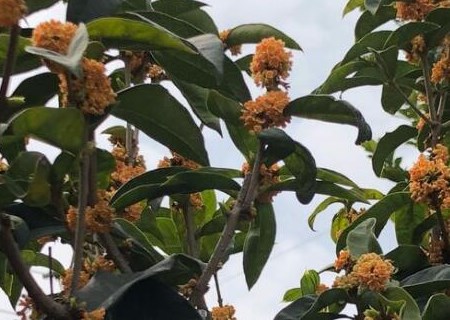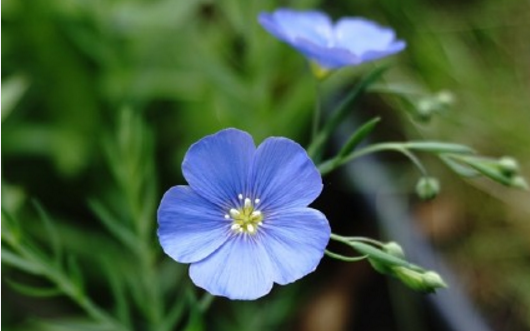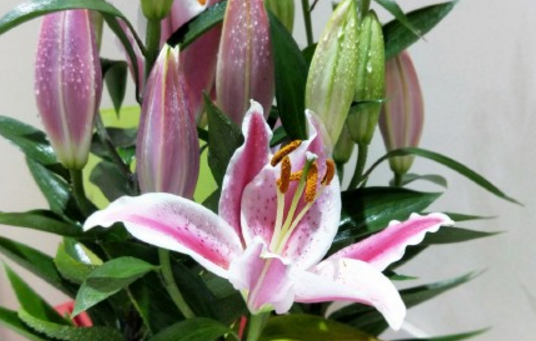Can I plant sweet-scented osmanthus trees in the yard? What are the methods of potted culture? What's the use?
Sweet-scented osmanthus fragrance, recently sweet-scented osmanthus has been in bloom, walking in the street sweet-scented osmanthus think of pervading the street, like very much, some people want to plant sweet-scented osmanthus in the yard, then do you know that sweet-scented osmanthus trees can be planted in the yard? What are the methods of potted culture? What's the use?

Can sweet-scented osmanthus trees be planted in the yard
The inability to grow sweet-scented osmanthus is basically derived from the old saying. There are clouds in the Yin-Yang House Classic; sweet-scented osmanthus flowers in the courtyard and ghosts outside the house. Both ancient and modern sweet-scented osmanthus trees are a sign of bad luck in the family. There are also clouds; in front of the sweet-scented osmanthus tree, dignitaries stand inside. Therefore, it is said that the number of sweet-scented osmanthus is not good for planting in the door, but if it is planted in front of the door, it is an auspicious picture, and if it is planted in the courtyard, it will lead to evil spirits to be admitted to the hospital, which is unlucky, and there will often be disputes between words and words.
There is also a saying that sweet-scented osmanthus trees are flowering plants, and it is best not to plant them too close to the house, still less can they be planted in the position of the peach blossom, because the peach blossom is called the peach blossom position, and the plant blossoms have pollen. Pollen is a stimulant that stimulates hormonal excitement. Under the influence of the earth's magnetic field and aura, if peach blossoms are exuberant in every passing year, it is easy for the family to have an affair. Although it is a superstition, I still don't believe it if I believe it. Sweet-scented osmanthus can be planted at home, but it depends on whether you respect superstition.
2. what are the methods of potted culture of sweet-scented osmanthus trees
1. The location of potted sweet-scented osmanthus trees
Sweet-scented osmanthus bonsai should be placed in a warm and sunny place and should be properly sheltered in summer to avoid direct light. The area north of the Yangtze River must be put indoors in winter, and it is safe to keep 0-5 ℃ at room temperature. You can leave the room before and after the sting in the spring of the following year.
2. Watering methods of potted sweet-scented osmanthus trees:
The pot soil of sweet-scented osmanthus trees should grasp the principle of whether it is dry or irrigated, and if it is watered thoroughly. Generally, it is watered every 3-4 days in spring and autumn, once every day in summer and every 7-10 days in winter. It must be watered in the morning and evening in summer and around noon in winter, so that the water temperature is close to the soil temperature and does not cause sudden cold and heat and damage the root system. Appropriate amount of water should be watered in autumn, and the basin soil should be prevented from getting too wet or stagnant water in the rainy season.
3. Fertilization methods of potted sweet-scented osmanthus trees
The bonsai of sweet-scented osmanthus trees is mainly for viewing flowers and should be provided with adequate fertilizer. During shoot shooting, nitrogen fertilizer could be applied 1-2 times to promote the growth of branches and leaves, while phosphorus fertilizer was mainly applied before flower bud differentiation and flowering. Before applying fertilizer, the basin soil should be a little drier, and it is appropriate to loosen the soil so that the fertilizer can be absorbed. Water should be watered once on the second day of fertilization. If compost or stable compost is used, it must be completely rotten before use. When applying chemical fertilizer, the concentration of calcium superphosphate should not exceed 2%.
4. Pruning methods of potted sweet-scented osmanthus trees:
The shaping and pruning of sweet-scented osmanthus trees should be carried out after autumn, and the upper branches should be cut off to balance the tree. The branches that are too dense should be thinned, and the diseased branches should be removed to concentrate nutrients for flowering. Plastic pruning combined with water and fertilizer management can improve the robust growth of sweet-scented osmanthus bonsai and maintain a graceful posture.
5. Change the pot of potted sweet-scented osmanthus trees:
Sweet-scented osmanthus bonsai can be turned over and changed soil every 2-3 years. The new pot should be larger to facilitate the root growth of sweet-scented osmanthus. Combined with turning the basin, cut off part of the old and withered roots, use bamboo sticks to remove part of the old soil, replace it with loose and fertile new culture soil, and place rotten cake fertilizer at the bottom of the basin as the base fertilizer, the fill must be compacted, which can promote sweet-scented osmanthus blossom and luxuriant leaves.
6. diseases and pests to be controlled in potted sweet-scented osmanthus trees:
The common diseases of sweet-scented osmanthus include leaf spot, coal pollution, algal spot, root rot, iron deficiency and so on.
① leaf spot, coal fouling and algal spot can be controlled by spraying 0.5 Bordeaux solution or 5% carbendazim 500-1000 times.
For the prevention and control of ② root rot, attention should be paid to keeping the soil loose and permeable without stagnant water. If root rot is caused by fungi, the root can be irrigated with 200-300 times solution of benzoammonium.
The common pests of ③ sweet-scented osmanthus are leaf wasp, whitefly, mite, white scale, yellow moth and so on. Leaf wasps, whitefly and mites can be sprayed with 1500-3000 times of dimethoate. In addition to manual brushing, the scale can be sprayed with 1000 times of omethoate or 500 times of fenitrothion.
What is the use of Osmanthus fragrans
1. The medicinal value of Osmanthus fragrans.
Sweet-scented osmanthus is used as medicine in flowers, fruits and roots, picking flowers in autumn, picking fruits in spring, picking roots in the four seasons and drying them respectively. It has the effect of dispelling cold and breaking knot, resolving phlegm and relieving cough. it is used for toothache, cough and dyspnea, dysmenorrhea and abdominal pain. Fruity pungent, sweet, warm, with the effect of warming the stomach, calming the liver and dispelling cold, for deficiency and cold stomachache. Root sweet, slightly astringent, sexual flat, with the effect of dispelling rheumatism and dispelling cold, for rheumatic muscle and bone pain, low back pain, kidney deficiency toothache and other diseases.
2. Dietary effect of Osmanthus fragrans.
Sweet-scented osmanthus can make cakes, candies and wine. Common practices include glutinous rice sweet-scented osmanthus lotus root, sweet-scented osmanthus yellow forest crisp, sweet-scented osmanthus cake, wolfberry sweet-scented osmanthus tea, sweet-scented osmanthus purple potato glutinous rice, sweet-scented osmanthus milk tofu, sweet-scented osmanthus wine brewed fine round seed, roasted sweet-scented osmanthus sausage, sweet-scented osmanthus Almond Jelly, sweet-scented osmanthus small bean porridge and so on. The ancients believed that osmanthus is the best medicine, so the wine brewed with sweet-scented osmanthus can achieve the effect of "drinking a thousand years of life". Sweet-scented osmanthus tea can nourish beauty, relieve throat, improve phlegm and cough symptoms, treat duodenal ulcer, Reed measles, stomach cold and stomachache, bad breath, unclear vision and so on.
3. Garden use of sweet-scented osmanthus
Sweet-scented osmanthus is evergreen all the year round, with luxuriant branches and luxuriant leaves, blooming in autumn and overflowing with fragrance. It is widely used in gardens. It is often used as landscape trees, such as solitary planting, opposite planting, and forest planting in clumps. In Chinese classical gardens, it is often matched with buildings, mountains and stone machines, and tufted shrubby plants are planted near pavilions, platforms, buildings and pavilions. Sweet-scented osmanthus in ancient Chinese poems, the number of works of chanting cinnamon is also considerable, and it has been deeply loved by the Chinese people since ancient times, which means lofty, beautiful, auspicious, friendly, loyal people, straight and unyielding, fairy friends, fairy guests and so on.
Time: 2019-03-17 Click:
- Prev

How to plant blue flax seeds of Rosa subclass? How to cuttage? When will it blossom?
Lanhua Yaxi has sufficient light and strong cold tolerance. Because of its strong adaptability, it can be used as ornamental food, so how to grow blue flax seeds? How to cuttage? When will it blossom? According to the data, blue flax is a plant that likes light, and its adaptability is strong, and its cold tolerance is not weak.
- Next

What are the cultivation methods of maryland-family deer onions? What's the difference between changing brocades? How to reproduce?
Deer onions like to grow in the sun, humid environment, such as damp slopes, rocks and cliffs, then what cultivation methods deer onions? What's the difference between changing brocades? How to reproduce? According to the information, deer onions prefer light, it is suitable for growing in a humid environment. But it can withstand semi-shade and drought
Related
- Fuxing push coffee new agricultural production and marketing class: lack of small-scale processing plants
- Jujube rice field leisure farm deep ploughing Yilan for five years to create a space for organic food and play
- Nongyu Farm-A trial of organic papaya for brave women with advanced technology
- Four points for attention in the prevention and control of diseases and insect pests of edible fungi
- How to add nutrient solution to Edible Fungi
- Is there any good way to control edible fungus mites?
- Open Inoculation Technology of Edible Fungi
- Is there any clever way to use fertilizer for edible fungus in winter?
- What agents are used to kill the pathogens of edible fungi in the mushroom shed?
- Rapid drying of Edible Fungi

